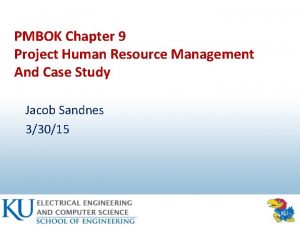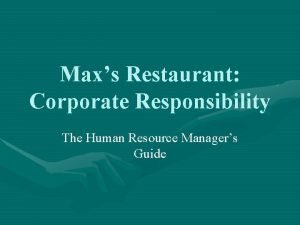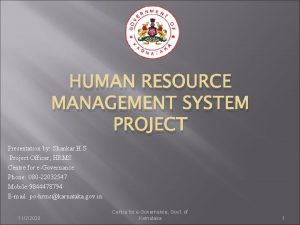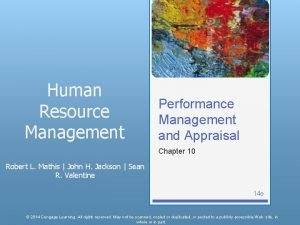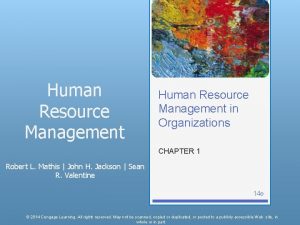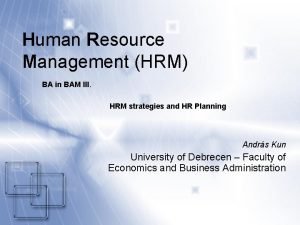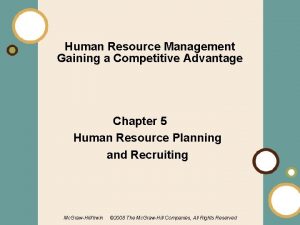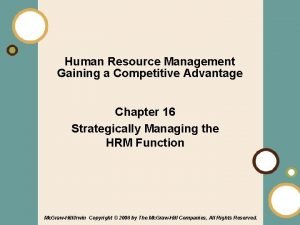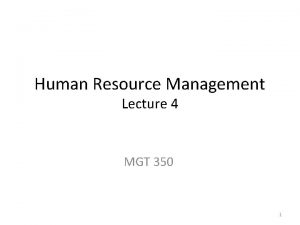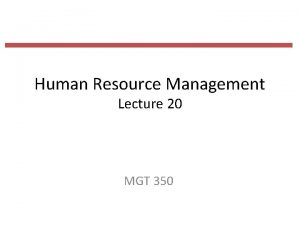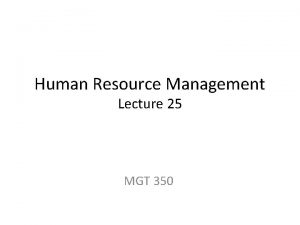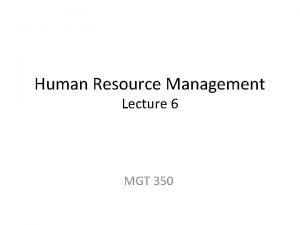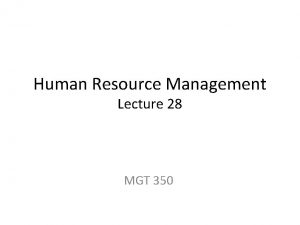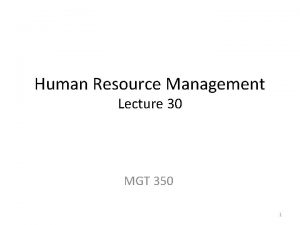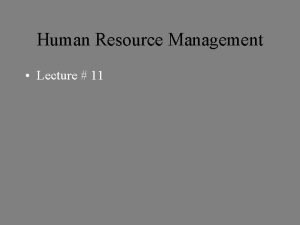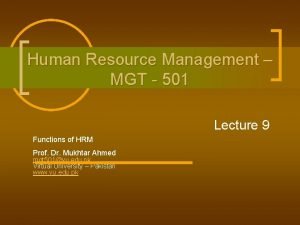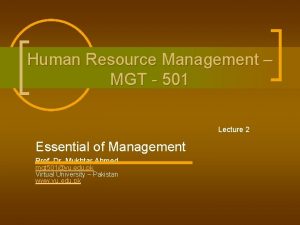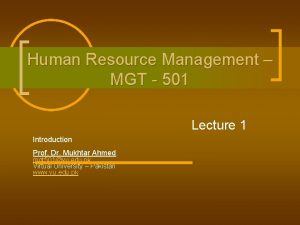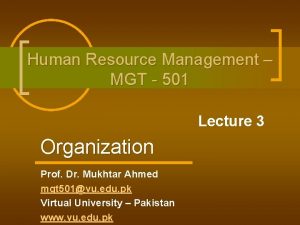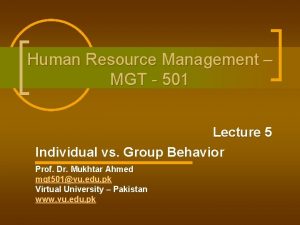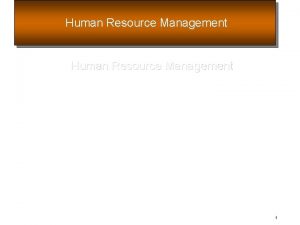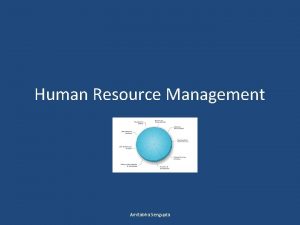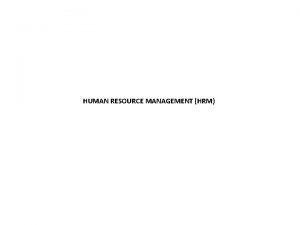Human Resource Management Lecture 1 MGT 350 1
























- Slides: 24

Human Resource Management Lecture 1 MGT 350 1

Introduction • • Name Qualification Experience Research Work 2

Lecture outline • First part: – Introduction to the module • Second part: – Introduction to Human Resource Management (HRM) 3

Introduction to the module First Part 4

MODULE OBJECTIVES To understand comprehend: • What is HRM? • What is the importance of HRM? • HRM Process and Functions – – – – Recruitment and selection Orientation and Training Performance management Compensation and benefits Career Development Safety and Health Labour Laws in Pakistan 5

Course structure • Lectures: 32 lectures • Recommended text: • Fundamentals of Human Resource Management, By David A. De. Cenzo, Stephen P. Robbins and Susan L. Verhulst. 6

Course Topics • UNDERSTANDING HRM – The Dynamic Environment of HRM – Fundamentals of Strategic HRM • LEGAL AND ETHICAL CONTEXT OF HRM – Equal Employment Opportunity – Employee Rights and Discipline • STAFFING THE ORGANIZATION – Human Resource Planning and Job Analysis – Recruitment – Selection 7

Course Topics • TRAINING AND DEVELOPMENT – Socializing, Orienting, and Developing Employees – Managing Careers • MAINTAINING HIGH PERFORMANCE – Establishing the Performance Management System – Establishing Rewards and Pay Plans – Employee Benefits – Ensuring a Safe and Healthy Work Environment • MANAGEMENT ENVIRONMENTS – Understanding Labor Relations and Collective Bargaining 8

Introduction to HRM Second Part 9

Organization and HRM • Organizations have different departments. – Finance – Marketing – Research and Development – Human Resource Management 10

Human Resource Management • No universal definition • Term originated in the USA • Initially interchangeable with ‘Personnel Management’ • Managing Humans (Employees) • The management of people to do the work. (Boxall and Purcell 2012) 11

Human Resource Management Human resource management is the management of an organization's workforce, or human resources. The process by which managers ensure that they have the right number and kinds of people in the right places, and at the right times, who are capable of effectively and efficiently performing their tasks.

Managerial Concerns – Efficiency – Getting the most output for the least inputs – Effectiveness – Attaining organizational goals 1– 13

Human Resource Management Process

Human Resource (HR) Planning • Assessing current human resources • Assessing future needs for human resources • Developing a program to meet those future needs • Demand – supply = Gap (surplus/shortage) 12– 15

Recruitment and Decruitment • Recruitment – The process of locating, identifying, and attracting capable applicants to an organization. • Decruitment – The process of reducing a surplus of employees in the workforce of an organization. 12– 16

Selection • Selection Process – The process of screening job applicants to ensure that the most appropriate candidates are hired. 12– 17

Orientation • Planned introduction of new employee to his/her job, co-worker and the organization. 12– 18

Employee Training • Employee Training is a learning experience designed to achieve a relatively permanent change in an individual that will improve the ability to perform on the job. • Up-to dated Skills.

Employee Performance Management – A process of establishing performance standards and appraising employee performance in order to arrive at objective HR decisions and to provide documentation in support of those decisions. 12– 20

Compensation and Benefits • Compensation is the total amount of the monetary and non-monetary pay provided to an employee by an employer in return for work performed as required. • Internal equity/External Equity 12– 21

Career Development • Career Defined – The sequence of positions held by a person during his or her lifetime is called career. 12– 22

The Importance of Human Resource Management (HRM) • As a necessary part of the organizing function of management – Selecting, training, and evaluating the work force • As an important strategic tool – HRM helps establish an organization’s sustainable competitive advantage. • Adds value to the firm – High performance work practices lead to both high individual and high organizational performance. 23

Summary • • • Title and Course Code Introduction Text Book Chapters (Course Topics) What is HRM (managing people/ employees) The importance of HRM (Important function) 24
 Management fifteenth edition
Management fifteenth edition Human resource management chapter 1
Human resource management chapter 1 Human resource management lecture chapter 1
Human resource management lecture chapter 1 Time management human resources
Time management human resources Retail store organizational structure
Retail store organizational structure Human resources defintion
Human resources defintion 01:640:244 lecture notes - lecture 15: plat, idah, farad
01:640:244 lecture notes - lecture 15: plat, idah, farad Project human resource management pmbok ppt
Project human resource management pmbok ppt Resource management pmbok
Resource management pmbok Importance hrm
Importance hrm Human resource management in restaurants
Human resource management in restaurants Human induction meaning
Human induction meaning Hrm chapter 2
Hrm chapter 2 Chapter 9 human resource management
Chapter 9 human resource management Human resource management system project
Human resource management system project Performance appraisal in human resource management
Performance appraisal in human resource management Current issues in human resource management
Current issues in human resource management Ba human resource management
Ba human resource management Acas discrimination
Acas discrimination Human resource management gaining a competitive advantage
Human resource management gaining a competitive advantage Human resource management gaining a competitive advantage
Human resource management gaining a competitive advantage Human resource management gaining a competitive advantage
Human resource management gaining a competitive advantage Human resource management final exam
Human resource management final exam Human resource management fifteenth edition
Human resource management fifteenth edition Line and staff aspects of hrm
Line and staff aspects of hrm








